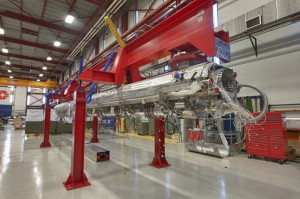Fermilab researchers will soon take a quantum step towards the realisation of an ILC-type cryomodule.
Next week the newly assembled cryomodule RFCA002, familiarly referred to as CM2, will replace CM1 in the Advanced Superconducting Test Accelerator at the laboratory’s NML test facility. The change-out is a rung up on the R&D ladder, and not only because it is the second eight-cavity cryomodule to come out of the laboratory. Far more than the first, CM2 resembles an ILC-type cryomodule in its components and cavity test performance.
“The hope for CM2 is that it will be the first cryomodule to reach the average ILC specification gradient at Fermilab,” said lead engineer Tug Arkan. The so-called S1 goal of the ILC programme is to achieve an average gradient of 31.5 megavolts per metre over eight metre-long cavities. “That’s the goal to demonstrate. We haven’t yet proved it at Fermilab.”
But they came teasingly close to a different goal. Prior to their being installed in CM2, six of its cavities individually reached or exceeded the ILC specification of 35 MV/m in their horizontal tests. Two fell just shy of the mark, achieving 33 MV/m. (One of these did not receive a final horizontal test after it achieved 36 MV/m in a vertical test, a result of additional surface processing conducted after an earlier poor horizontal test.) Practically speaking, CM2 components are up to ILC standards so far.
“That’s the vital thing,” said Elvin Harms, who leads the cryomodule commissioning and testing programme. “This is an ILC cryomodule.”
The high cavity performance brings the S1 goal that much more within reach. And with 15 months of lessons learned from operating CM1, the CM2 team has plenty of accumulated expertise to draw from.
“Running CM1 was a great opportunity to cut our teeth on operating a multi-cavity cryomodule,” Harms said. “The run was satisfying and very instructive for the whole team. We did all the measurements we set out to do, and have done a lot not just with the device itself, but also commissioned all the subsystems that are necessary for safe and reliable operation.”
These recordings were made as part of CM1 Lorentz force detuning compensation work. When radiofrequency power is applied to CM1, cavity 4, it begins to vibrate because of pressure from the electromagnetic field. The vibration waveform is captured by a piezoelectric sensor connected to the beam flange of the cavity.
Although demonstrating its operability and measuring its performance parameters have been the prime goals since CM1 was installed in 2010, Lorentz force detuning compensation has been demonstrated to a level considered by many to be the world standard. And, in a nice case of one R&D programme helping to support another, the team used CM1 to provide proof of principle that the nine-millisecond beam pulse required by the proposed Project X proton accelerator was feasible. Further, as an unscheduled activity, the team even nailed down and fixed a nitrogen leak without having to pull out the cryomodule, which itself proved to be a valuable learning experience.
Cavity 5 is not powered, but is mechanically in contact with cavity 4 (sound file above), so it still vibrates. Files courtesy of Warren Schappert and Yuriy Pischalnikov.
Once CM1 is uninstalled, the Fermilab team will conduct a post-mortem to identify weak points in its operation. Three of the cavities underperformed, and one of the tuners stopped working almost before it started.
Researchers hope to be able to more readily assess CM2’s performance, as they’ll enjoy the advantage of having all of its data at their fingertips. Unlike CM1, which was assembled from a DESY kit and with the help of DESY and INFN staff, CM2 is home-grown. Though many of its components were purchased from Europe, US personnel put it together. Moreover, all eight of its cavities were processed and tested at Fermilab and Jefferson Lab.
The high-gradient cavities aren’t the only components that nudge CM2 towards being an ILC type. Its tuners, designed by INFN in Italy, will replace the kind used in CM1. They will be moved from the ends of the cavities, where they sat in CM1, to the cavities’ centres.
CM2 will first undergo warm tests. It will then be cooled down, at which point it will be put through cold tests and, with some good fortune, by early 2013, tests with beam.
For the RF systems, beam opens up a whole new dynamic. Beams consume power and the low-level system has to compensate while remaining stable.
“Let’s hope the average gradient of this cryomodule runs at 31.5. Is it a realistic hope?” Arkan asked. “It’s not an easy task, but we’re trying everything in our power to do it. Now we test and see what’s going to happen.”


Recent Comments